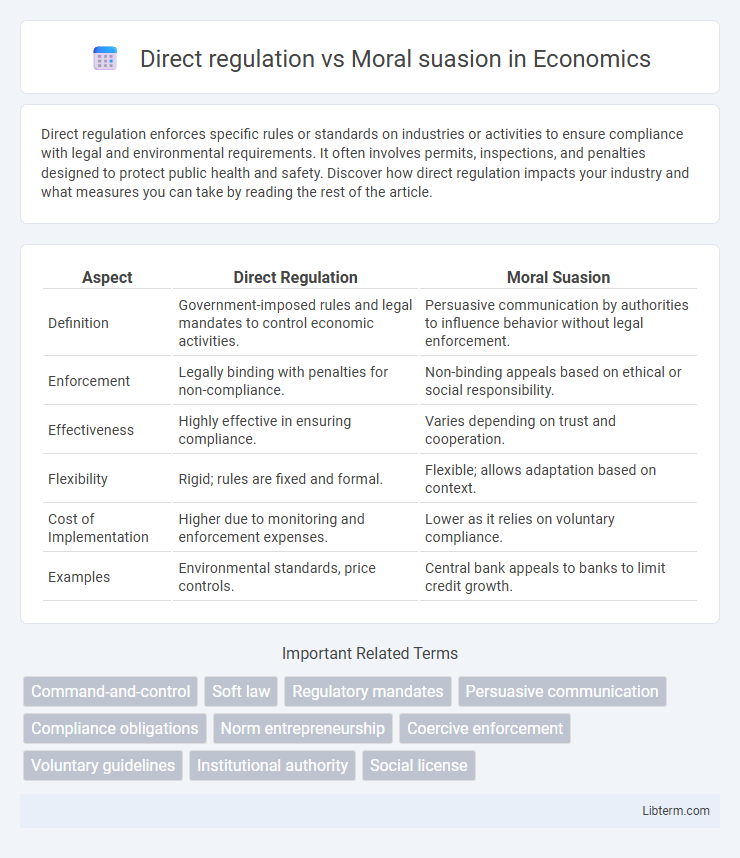Direct regulation enforces specific rules or standards on industries or activities to ensure compliance with legal and environmental requirements. It often involves permits, inspections, and penalties designed to protect public health and safety. Discover how direct regulation impacts your industry and what measures you can take by reading the rest of the article.
Table of Comparison
| Aspect | Direct Regulation | Moral Suasion |
|---|---|---|
| Definition | Government-imposed rules and legal mandates to control economic activities. | Persuasive communication by authorities to influence behavior without legal enforcement. |
| Enforcement | Legally binding with penalties for non-compliance. | Non-binding appeals based on ethical or social responsibility. |
| Effectiveness | Highly effective in ensuring compliance. | Varies depending on trust and cooperation. |
| Flexibility | Rigid; rules are fixed and formal. | Flexible; allows adaptation based on context. |
| Cost of Implementation | Higher due to monitoring and enforcement expenses. | Lower as it relies on voluntary compliance. |
| Examples | Environmental standards, price controls. | Central bank appeals to banks to limit credit growth. |
Introduction to Direct Regulation and Moral Suasion
Direct regulation involves legally binding rules imposed by authorities to control behaviors, such as environmental laws setting emission limits for industries. Moral suasion relies on appealing to individuals' or organizations' ethical values and social responsibilities to encourage voluntary compliance without legal enforcement. Both approaches aim to influence behavior, with direct regulation providing mandatory standards while moral suasion promotes goodwill and self-regulation.
Defining Direct Regulation: Key Features
Direct regulation entails legally binding rules imposed by governmental authorities to control behaviors and enforce compliance through penalties or sanctions. It features clear, specific standards, mandatory compliance requirements, and formal enforcement mechanisms such as inspections and fines. This approach provides certainty and uniformity in addressing issues like environmental protection, public health, and corporate governance.
Understanding Moral Suasion: Core Principles
Moral suasion relies on influencing behavior through ethical appeals and societal norms rather than legal mandates, encouraging compliance by appealing to individuals' sense of duty and social responsibility. It emphasizes persuasion, trust-building, and voluntary cooperation, often used by governments or institutions to promote desirable actions without formal enforcement. Unlike direct regulation, which imposes binding rules and penalties, moral suasion leverages intrinsic motivation and public accountability to achieve policy objectives effectively.
Historical Context of Regulatory Approaches
Direct regulation historically emerged during the industrial revolution to control pollution and labor conditions through binding laws and standards enforced by governmental agencies. Moral suasion, in contrast, relies on voluntary compliance and ethical appeals, prominently used in the early 20th century during the U.S. Federal Reserve's efforts to influence banking behavior without formal legislation. The evolution from moral suasion to direct regulation reflects shifts in policy tools responding to increasing complexity and scale of economic activities requiring enforceable oversight mechanisms.
Comparative Effectiveness: Direct Regulation vs Moral Suasion
Direct regulation enforces compliance through legally binding rules and penalties, ensuring immediate and measurable outcomes, especially effective in reducing pollution levels and ensuring workplace safety. Moral suasion relies on persuasion and appeals to ethical standards, fostering voluntary compliance and long-term behavioral change but often lacks enforceability and consistent results. Comparative studies indicate direct regulation achieves faster, more uniform results, while moral suasion is more effective where intrinsic motivation aligns with regulatory goals.
Policy Implementation: Challenges and Opportunities
Direct regulation imposes legally binding rules that ensure compliance but often faces challenges such as enforcement costs and resistance from regulated entities. Moral suasion leverages persuasion and ethical appeals to influence behavior, which can reduce enforcement expenses yet struggles with inconsistent adherence and limited accountability. Combining these approaches allows policymakers to balance strict enforcement with flexibility, enhancing overall effectiveness in achieving regulatory objectives.
Economic Impact of Regulatory Strategies
Direct regulation imposes mandatory rules and penalties that create clear compliance costs and can lead to short-term economic disruptions, but often result in predictable market adjustments and efficiency gains over time. Moral suasion leverages persuasion and voluntary compliance, minimizing immediate economic burdens but potentially causing slower behavioral changes and less consistent outcomes across industries. Economically, direct regulation tends to drive more robust innovation incentives by setting firm standards, while moral suasion relies on market participants' goodwill, which can limit its effectiveness in achieving large-scale economic impact.
Real-World Examples and Case Studies
Direct regulation enforces compliance through laws and penalties, exemplified by the U.S. Environmental Protection Agency's cap-and-trade system for emissions, which mandates strict pollution limits. Moral suasion leverages appeals to ethical responsibility, as seen in India's energy conservation campaigns encouraging households and businesses to reduce electricity usage without legal compulsion. Case studies comparing these approaches reveal direct regulation's immediate impact in reducing harmful activities, while moral suasion fosters longer-term behavioral change through public awareness and social norms.
Stakeholder Responses to Regulation Types
Stakeholder responses to direct regulation often involve formal compliance efforts, increased reporting, and adherence to specific legal standards, driving operational changes within firms. In contrast, moral suasion relies on voluntary cooperation and ethical appeal, leading stakeholders to adjust behavior based on corporate social responsibility and reputational concerns. Empirical studies reveal that direct regulation prompts immediate, measurable compliance, while moral suasion fosters longer-term commitment and intrinsic motivation among key stakeholders such as customers, investors, and employees.
Future Trends in Regulatory Frameworks
Future trends in regulatory frameworks emphasize a shift from direct regulation toward moral suasion to enhance compliance through ethical persuasion and voluntary adherence. Governments and regulatory bodies increasingly leverage behavioral insights and social norms to influence corporate and individual actions without imposing rigid mandates. Advances in digital transparency and real-time monitoring enable regulators to encourage proactive self-regulation, fostering a collaborative environment between authorities and stakeholders.
Direct regulation Infographic

 libterm.com
libterm.com